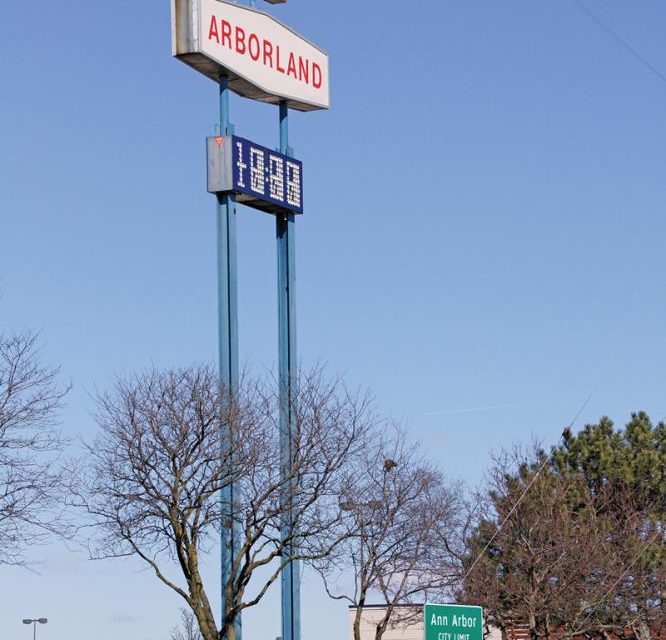Brixmor Property Group announced last month that it had bought Arborland for $102 million. Also the owner of the much-upgraded Maple Village, Brixmor is a huge real estate trust formed in 2013 from the remnants of other similar companies. It seems to have made it its mission to aggressively reestablish retail “open-air shopping centers” in non-downtown locations.
The commitment to traditional shopping is baked into the name: “Brixmor” is a play on “bricks and mortar.” Its formula is to use grocery stores as anchors, to carefully groom and maintain the exteriors, to populate the rest of the spaces from a collection of its favored brands (a list of what’s currently at Arborland and what’s new at Maple Village pretty much sums it up), and to be on the lookout for up-and-coming local businesses.
Those quotation marks around “open-air shopping center”? Pay attention to them. You’ll get a rap on the knuckles if you confuse “open-air shopping center” and “mall” within the Brixmor biosphere. A publicist paving the way for an interview specifically warned of the danger of using the dreaded m-word with Mark Horgan, corporate investing officer of Brixmor. As it turned out, though, he was happy to explain the difference.
“I like malls as much as anyone. Briarwood is fantastic,” he says (New York-based Horgan used to work for Mills Corporation, Briarwood’s previous owner). But the distinction between a mall and an open-air center is a crucial one at Brixmor: “Malls have a roof, and we don’t. We think a lot about costs for the tenants. They’re called CAM charges.” The industry acronym for “common area maintenance” means the cost of keeping a large, enclosed center area “swept, cool, and warm,” says Horgan succinctly. “Also, in malls, you generally have less control over your anchor tenants, because they’re so big and are often partners in the development.”
Arborland, built in the early 1960s to catch the cross traffic on Washtenaw and US-23, has been refashioned several times into the shopping center du jour. Montgomery Ward and Penney’s were the original anchors. Later, an open-air courtyard was roofed, and it did time as an enclosed mall. That flopped, the anchors abandoned ship, and it was stripped back down into an open-air center filled with discount and outlet stores. Most recently, smaller businesses sprouted in its out lots and its grocery anchor, formerly Hiller’s, was acquired by Kroger. Its sale to Brixmor seems right on trend.
As for what the $102 million purchase price means in the tempest-tossed world of retail, Horgan calls it “a fair price.” It’s pretty much exactly what AMCAP paid for it in 2005, though AMCAP’s predecessor Freed had picked it up at its nadir in the late ’90s for $6 million.
Arborland probably originated more with an eye toward U.S.-23, but it’s the Washtenaw traffic that’s of interest these days. Washtenaw is more than a fast-food and gas-station-strewn conduit between two cities: it’s a straight shot to the non-mall from two of the richest neighborhoods in town, Burns Park and Ann Arbor Hills. Developers recognized its potential long ago, but now it’s apparent even to the rest of us that a methodical upgrade has been in progress and is moving east: Whole Foods, Barnes & Noble, and the glamorous Arbor Hills Crossing are by far the toniest end of the commercial strip, but even the renovated Washtenaw Commons across the street from Arborland seems poised to take in something more upscale with new and relatively upmarket tenants Blaze Pizza and Jamba Juice.
Horgan mentions Arbor Hills Crossing and the relative wealth of the adjacent neighborhoods and then turns the interview upside down, asking for input about local businesses with bright futures that might be interested in a Brixmor space. He also talks about the economy of scale afforded by two similar properties in Ann Arbor. “We’ve had tenants look at Arborland and decide they want to be at Maple Village,” he says, and presumably the opposite will be true, though at present there’s only one vacancy at Arborland: the stand-alone building vacated several years ago when Arhaus furniture jumped to Arbor Hills Crossing. In the future, he says he envisions more upscale restaurants and more high-end services–spas, exercise studios, and the like. Does a Kroger still fit in that picture? They’re “one of our largest tenants,” Horgan says. “We don’t see any reason for them to move.”


